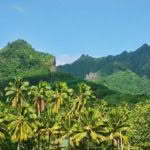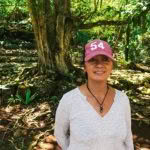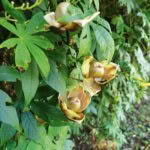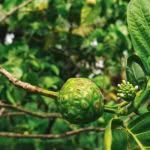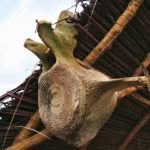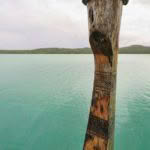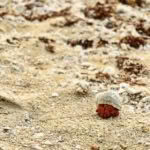Exploring the roads less traveled in the Cook Islands
- The mountain view from Ikurangi Eco Retreat
- Jimmy from Eco Cycle Tours.
- Teuira Pirangi of Highland Paradise.
- A “wood rose” growing on Maungaroa Mountain is not actually a flower but a seed pod used in traditional costumes.
- The Noni fruit is famed for its health benefits.
- A whale bone
- Exploring Aitutaki lagoon on a rainy day is a serene experience.
- A hermit crab
There are secrets to discover in the Cook Islands by following the road less traveled.
Words: Emma Rawson Photos: Andrew Long
The hibiscus had it coming. Our machete-wielding guide Mata George (a man of few words but with plenty of swing) takes no prisoners hacking back the wild tropical weed that has engulfed the steep slopes of Maungaroa Mountain, Rarotonga. But our Rarotongan Rambo has a right to take revenge – the hibiscus has been keeping secrets.
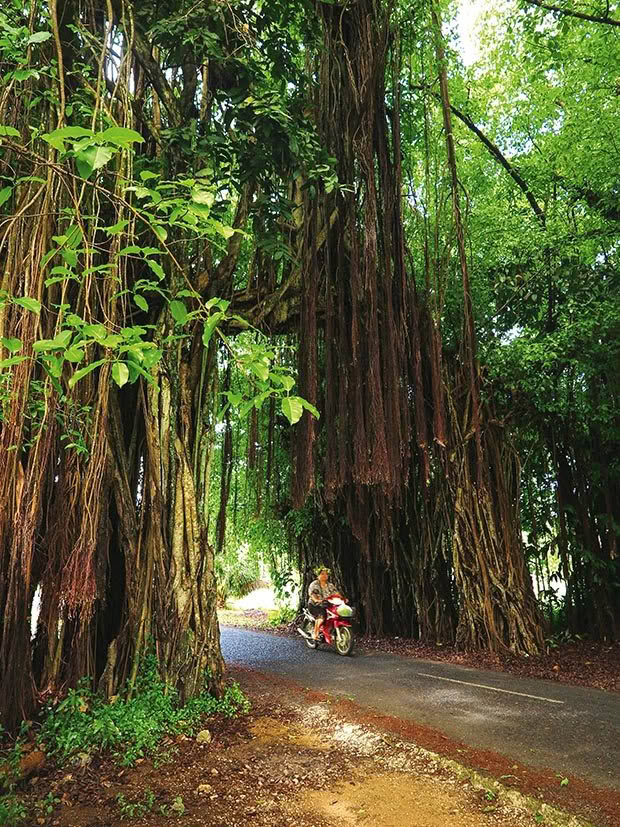
A scooter rider on Aitutaki.
Beneath the canopy is proof that giants once roamed the Cook Islands. The evidence? Two sets of footprints the size of boat oars worn into the stone lookout post of an ancient fortified marae. The big toe in one of the imprints, the size of a decent potato, marks the position where sentries once guarded the tinomana ariki (chief) of these hills. Although few have laid eyes on this marae in more than a century, signs of tribal life are everywhere: shell middens, pineapple plants and giant slabs of stone in a triangular formation.
“These are not rocks that are from here,” says Teuira Pirangi, the descendant of the high chief Tinomana Enuarutini Ariki and a modern-day guardian of this area. “Our ancestors must have been massive to lug these here. We don’t know how they did it.”
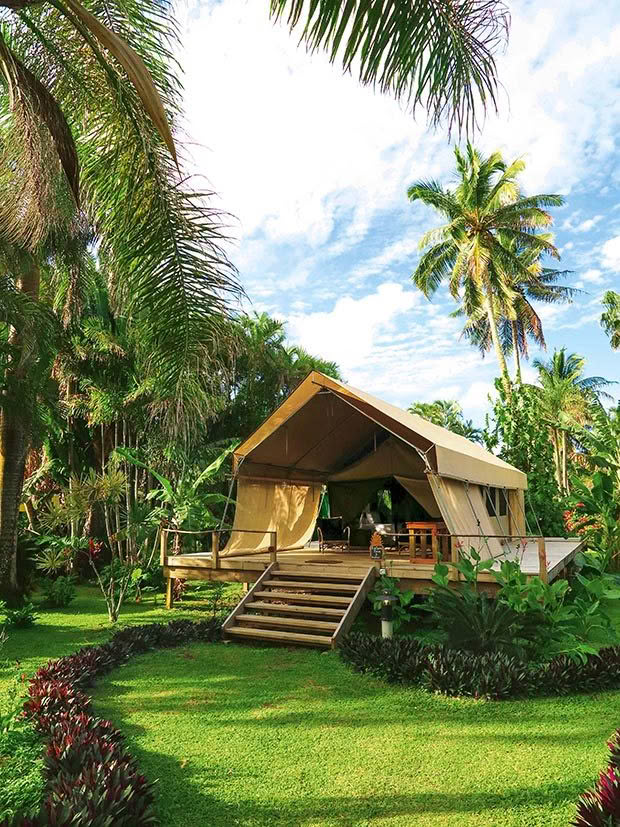
Glamping tents at Ikurangi Eco Retreat.
Teuira (or Tutu for short) is guiding me, my partner Andrew and four other visitors to one of 11 marae sites hidden in 82 hectares of dense bush belonging to the Puaikura tribe on the western side of the island. The land has been largely untouched since Tinomana Enuarutini Ariki – after meeting the missionary John Williams – persuaded the tribe to abandon its warfare with the neighbouring Takitumu vaka (tribe) and move down from these hills to the coast more than 175 years ago.
“I’ve never been here and I’m a local. This is special,” says fellow trekker Alice, gently digging up a wild orchid with a piece of banyan tree she is using as a walking pole. She will plant the flower in her garden, she says.
It is our last day in the Cook Islands, and this is not the path we expected our holiday to take. We’d envisaged sun, sand, snorkeling, azure water and relaxation. And we got that. But we also discovered another form of paradise when we turned our backs on the ocean and looked to the land within.
The Cook Islands are easy traveling for New Zealanders: three airlines fly to the islands, the currency is New Zealand dollars and visitors can bring food into the country easily. It takes only an hour for the local bus – driven by a man the Rarotongans call “Mr Hopeless” (for his lack of punctuality, although we didn’t experience that) – to travel the island’s 32-kilometre circumference.
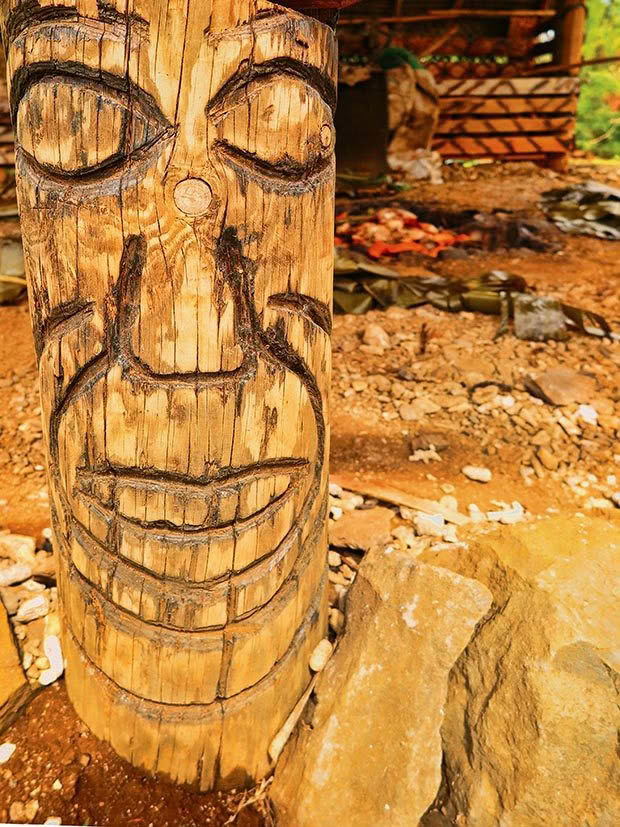
A carving near the Punarei Cultural Tour base in Aitutaki.
The outer ring road around the Cook Islands’ capital of Rarotonga is well worn by the scooter wheels and jandals of the New Zealand and Australian tourists who flocked to the Cook Islands in record numbers in 2016. But there are inland roads to explore and more colours to the Cooks than just the blue sea: the deep green of the mountains, rich orange-brown of the volcanic earth, the black of a spindly pineapple patch and the grey smoke of backyard umu earth ovens.
When we’d visited the clifftop Highland Paradise Cultural Centre for its award-winning cultural show a week ago, we’d begged Tutu to take us back to the off-limits-to-visitors marae sites at the edge of the centre. The facility has received UNESCO funding to help clear the overgrown foliage around the maraes, which are under review to become a World Heritage site. At present, the centre’s island feast and the impressive show bring in the crowds, but the marae sites are Tutu’s passion.
“I want Highland Paradise to be a university and a cultural centre for our people and visitors. Studying outdoors is a deeper form of learning. You remember more when you touch, smell and taste and when you are closer to the land.”
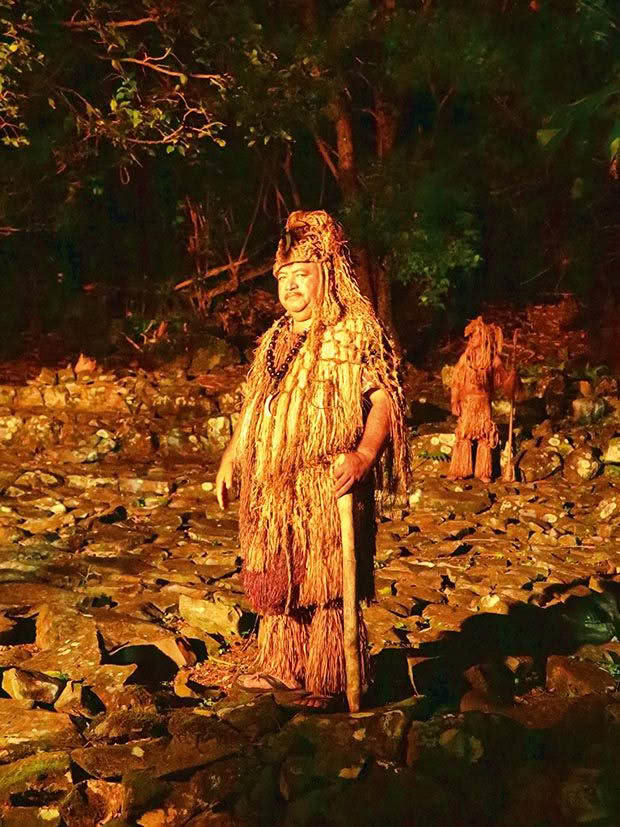
Highland Paradise’s master of ceremonies Danny Mataroa tells stories of tribal life on an excavated marae site.
Our change of focus from the sea to the landbegins when sleeping under the stars in safari tents. We’re staying at Ikurangi Eco Retreat on the North Eastern side of Rarotonga; it’s the only resort on Rarotonga facing the mountains and the only glamping resort of its kind in the Cook Islands. We wake to the sun rising over the side of the mountain, but the sea is not far from mind. Cool ocean air filters through the tent netting and cuts through the humidity. We can hear the surge of the ocean and sounds of the land: gecko squeaks, insect and birds chirps and roosters cock-a-doodle-doo-ing.
“You see the beautiful postcards from Tahiti showing the majestic mountains of Bora Bora but in Raro we always photograph looking outwards at the sea,” says Luana Scowcroft, who founded Ikurangi with her husband Matt in 2015. “I think when people think of Rarotonga they imagine the lagoon but we have something very special here, our mountains
are spectacular.”
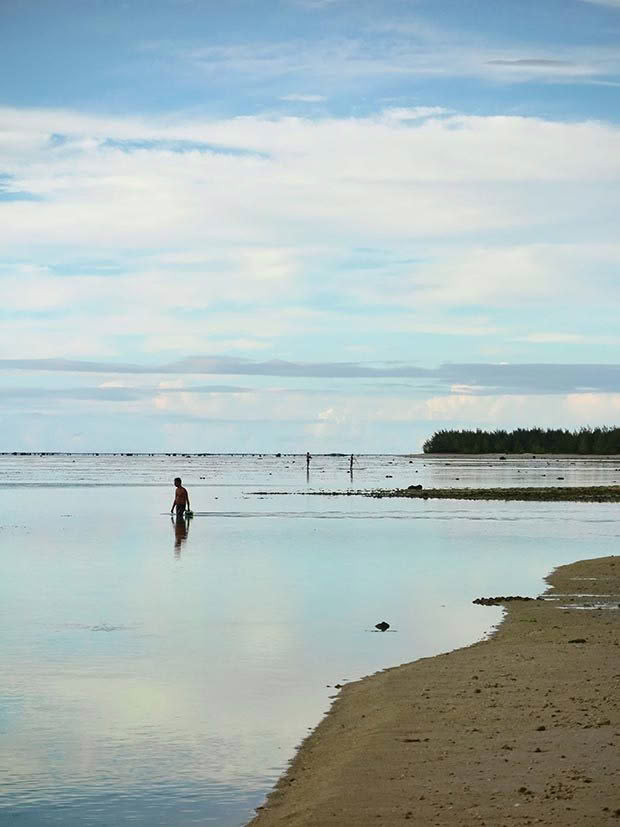
The cloud reflections on the still waters at Aitutaki make for dreamy end-of-day swimming, the
outgoing tide exposing the top of the coral.
The Scowcrofts are champions of ecotourism in Rarotonga. Ikurangi means “the tail of the sky” and is the name of the mountain that watches over the village of Matavera. The resort has an emphasis on the environment – there are luxury composting toilets, gardens are irrigated with wastewater and the couple are careful not to use excess packaging – think refillable bottles and no mini shampoos.
Luana grew up in Raro working in a hotel that her grandparents and parents owned and have since sold, and she has seen tourism grow. Rarotonga is at a crossroads, she says, as increasing tourism puts pressure on the Cook Islands’ infrastructure. The government’s commitment to using 100 per cent renewable energy by 2020 is an opportunity to lead the way in the Pacific, she says.
“Growing up here you realize the idea of conservation is a Western one,” says Luana, who went to university in Wellington before she had enough of the capital’s windy chill and returned home.
“In the islands, you don’t separate the environment from the rest of life. Conservation becomes about protecting resources. Everything is living and breathing.”
When Dave Furnell and his wife visited the Cook Islands for a wedding a few years ago, he couldn’t get the island out of his mind. The Sydney couple packed in their corporate jobs and returned in a matter of months. “I’m not saying there’s anything wrong with corporate life, it’s just this life is better,” he says. Dave is also spinning the wheels of ecotourism on the island with his bike tour business, Storytellers.
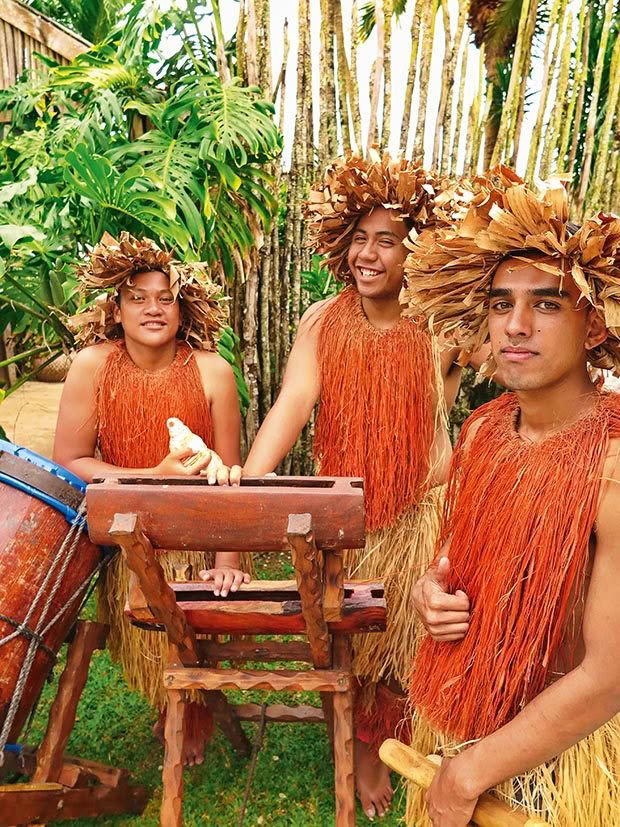
Cadet drummers about to practice their rhythms at Highland Paradise
We put the pedal to the metal road as a local called Jimmy guides us through the back streets beneath Maungaroa Mountain, telling us of the ancient battles between Puaikura and Takitumu. These days the only warfare between the tribes is on the rugby field, and this land is now a plantation area used for growing pineapple, taro, maniota (arrowroot) and noni – a green knobbly fruit that is turned into a fermented tonic. There’s no polite way of describing the taste of noni juice – a blend of old socks, prunes and cheese – but the Cook Islanders believe it has many health benefits, and the drink is exported to Asia where it fetches a premium.
A young girl in our group starts to feel queasy, not from noni but from “too many maniota fries last night”, says her mum shaking her head. Jimmy disappears and comes back holding some crushed “mile-a-minute” weed which he says will settle her tummy. He crushes it into a little ball, which the girl reluctantly consumes. “This is my first-aid kit,” he says, pointing to his machete. The junior rider is back on the road in a jiffy.
We ride past a grove of mandarin trees more than six-metres high, planted in the 1960s and once intended for export to New Zealand, and a kuru tree (breadfruit) that Jimmy tells us is a local barometer. Normally the tree has two fruit at the end of each branch but if a cyclone is on the way the trees start bearing three or four fruit per branch helping the village prepare for famine after the storm. By the end of our journey, we don’t feel tired but know we’ve done just enough exercise to justify an ice cream.
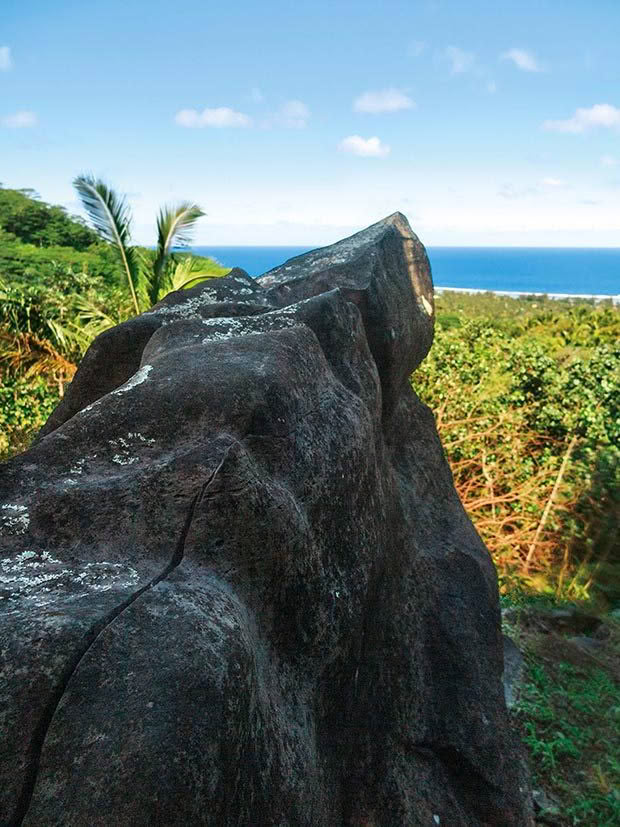
A stone at Maungaroa Mountain points directly to Aotearoa and was a navigation tool for journeys to the Land of the Long White Cloud.
Famed for its blue skies and lagoon, Aitutaki is a 50-minute flight from Rarotonga but when we arrive on the atoll the clouds are black and it’s bucketing with rain. It hasn’t rained in months a local tells us. Dusty umbrellas are produced, people look stunned. It’s 28 degrees, but pumpkin soup is on the menu at Tamanu Beach Resort’s barbecue night. Pumpkins grow wild on the island and when he was young Tamanu’s owner Nick Henry (grandson of Albert Henry, the prime minister who brought independence to the Cooks in 1965) says soup was a special rainy-day treat.
As the rain pounds, we return to storytelling. Nick tells us of his two-year voyage, traveling more than 32,000 kilometres of the Pacific in a traditional Polynesian vaka (waka). The journey, with seven other canoes from Polynesian and Melanesian nations, raised awareness for ocean conservation. “We had an expression during the journey: the vaka is an island, the island is a vaka,” says Nick.
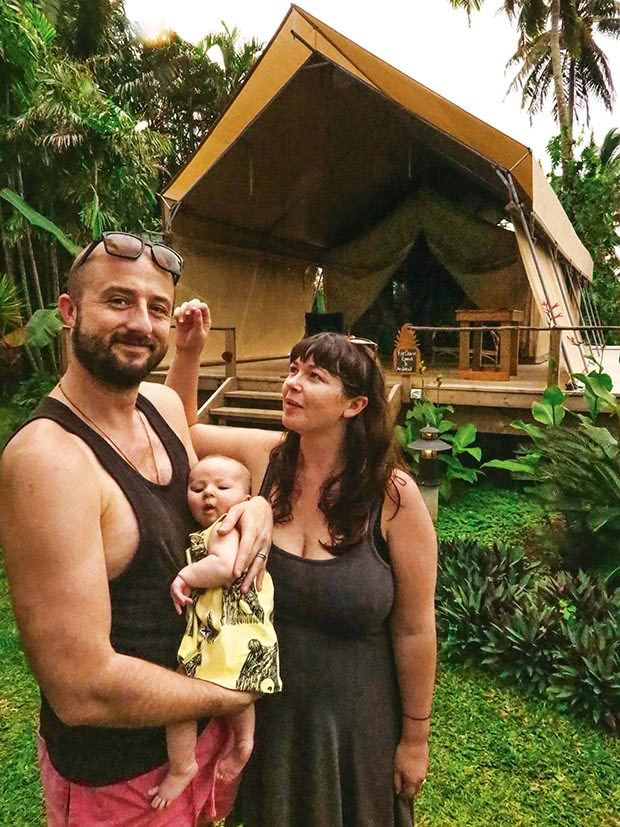
Shortly after opening Ikurangi, Matt and Luana Snowcroft’s daughter Evie was born.
“It’s about how land, sea and people are connected. We sailed past huge piles of rubbish and flotsam and jetsam in the sea near North America. I now have this constant feeling that we need to protect what’s out there,” gesturing at the hills and sea.
Traveling around Aitutaki, you can understand Nick’s passion. From the window of a 4WD, parts of the main island are pristine and untouched, and we see stones of a marae site and abandoned houses where locals have packed up their lives to find work in Rarotonga or New Zealand.
Exploring the lagoon from a catamaran the water, normally cyan, has become a deep turquoise in the rain. When we paddleboard from our boat to One Foot Island, one of the many motus (islands) scattered in the lagoon, it’s pouring and the raindrops pound the sea giving the clear water a jelly-like appearance. “This is surreal,” says Kathy, one of my fellow paddleboarders. “I don’t even mind that it’s raining, it’s just so beautiful.” We return to shore to find the earth is steaming and the air smelling of new life.
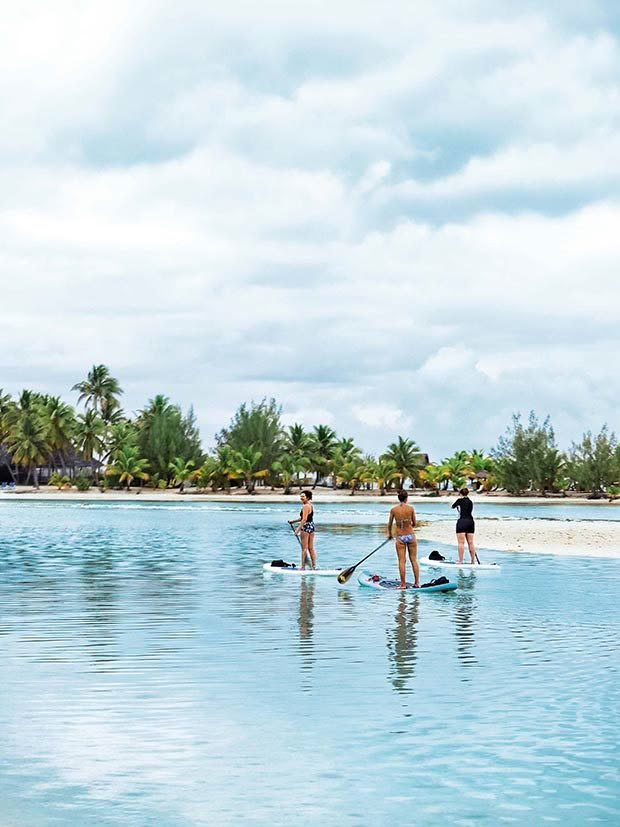
A sunrise paddleboard on the still waters of Aitutaki Lagoon; sunset at Manuia Beach Resort.
It is our final day in the Cooks and we are in back in Rarotonga but we forgo a morning on the water to return to the hills with Tutu. “We don’t want this place to be flashy and touristy, it needs to be authentic. Someone said to me I should put fairy lights up the driveway, but I don’t think my ancestors would like that,” she says. “We’re the guardians of this land. It doesn’t belong to us, we belong to the land.”
NOTEBOOK
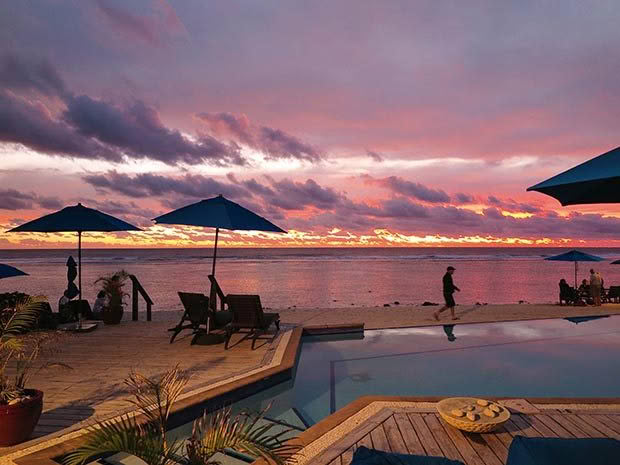
Getting there: Air New Zealand, Jetstar and Virgin Airlines all fly to Rarotonga from New Zealand. Once there, Air Rarotonga operates inter-island flights, including to Aitutaki.
Where to stay in Rarotonga: Ikurangi Eco Retreat. Away from the bustle of Muri Beach. Stay in luxury safari tents or if a roof is preferable there are permanent ares (huts). ikurangi.com
Manuia Beach Resort. Built before Rarotonga had an airport, this is one of the first beachside hotels on the island. It has an elegant vibe and fine dining in a sandy-floor restaurant. manuia.co.ck
Where to stay in Aitutaki: Tamanu Beach. Casual seaside ares accommodation. tamanubeach.com
What to do and see in the Cooks: Visit the cliffside open-air museums at the Highland Paradise Cultural Centre, Puaikura, Rarotonga, in the day or take in the Drums of our Forefathers sunset cultural show and feast, featuring bus driver Mr Hopeless, who is also one of the talented drummers. highlandparadise.co.ck
Discover Rarotonga by bike. Storytellers Eco Cycle Tours, Muri, caters for all abilities. Guides stop frequently to tell stories, allowing for a breather. Ten per cent of profits are returned to the community. storytellers.co.ck
Take a trip with Punarei Cultural Tours, Aitutaki. Weave a food basket before laying down the banana leaves for a feast. Tour around an ancient village with views of the lagoon in a 4WD and return in time to eat the spoils. aitutakiculturaltour.com
Try SUP yoga. Think a downward dog is hard on dry land? A SUP yoga session (yoga on a paddleboard) will challenge the body and the mind. Sunset sessions use boards featuring colourful lights underneath, transforming Muri Lagoon into a rainbow of colours. See Ariki Holidays, arikiholidays.com
Explore the lagoon. A lagoon scattered with more than a dozen motus (tiny islands) and sand bars surrounds the main island of Aitutaki. Guide Ted Tevai of Sailing Aitutaki offers catamaran sailing, windsurfing and paddleboard excursions. sailingaitutaki.com
Love this story? Subscribe now!
 This article first appeared in NZ Life & Leisure Magazine.
This article first appeared in NZ Life & Leisure Magazine.
